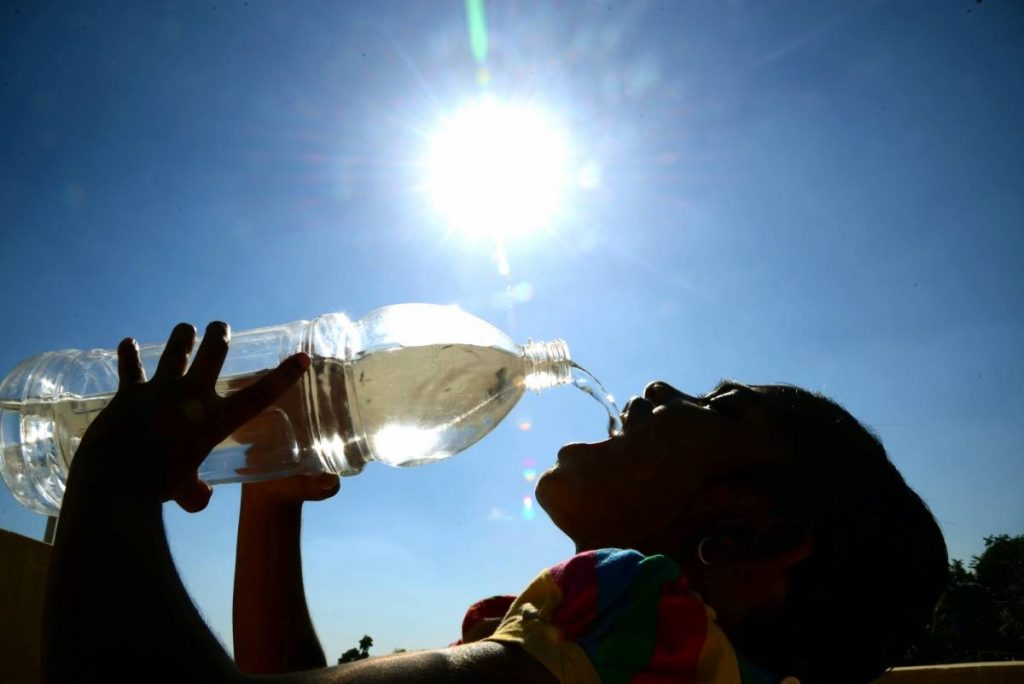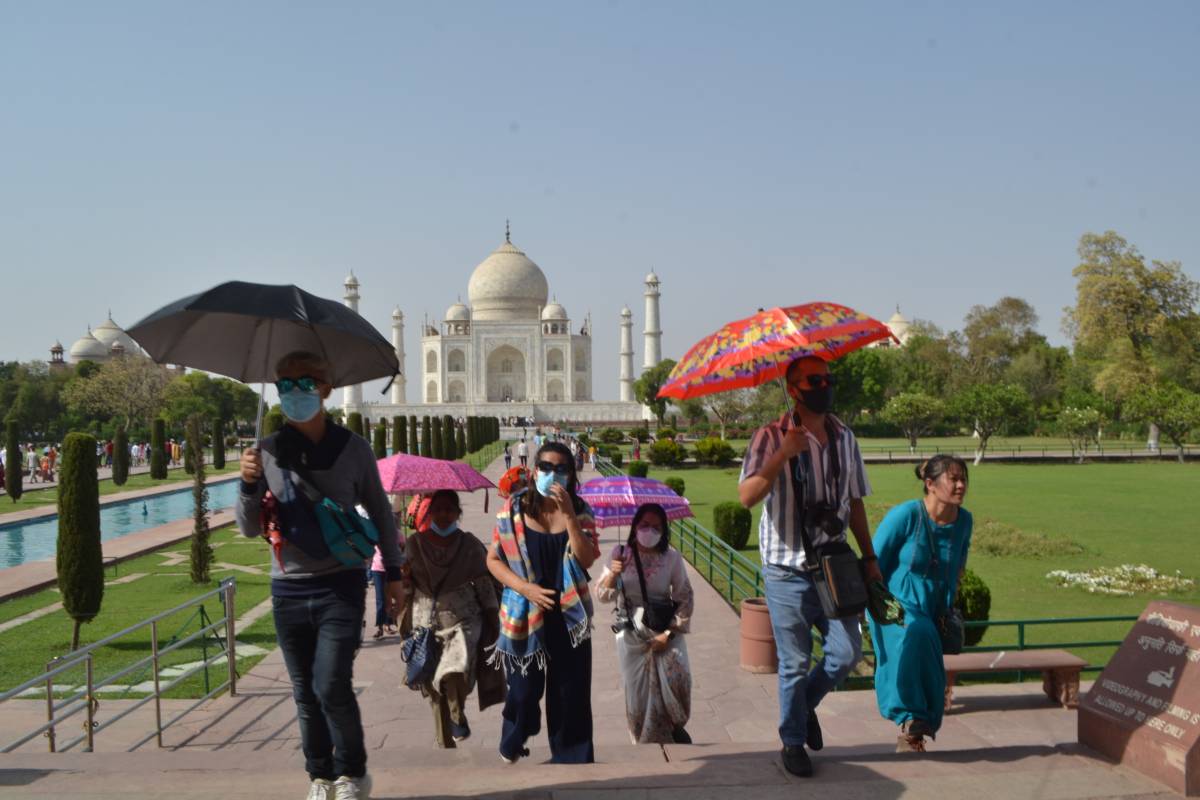The capital has recorded five heatwave days so far in April this year, the maximum in at least 12 years. It had recorded four such days in April 2017, the IMD data stated….reports Asian Lite News
Parts of north India sizzled under a punishing heatwave on Monday with the temperature breaking a five-year record for April in Delhi and hovering above the 40-degree mark in most parts of neighbouring Haryana and Punjab.
Some respite from the heat is likely in the region over the next few days. While cloudy conditions are expected in Delhi on Tuesday, a western disturbance may bring isolated rainfall over parts of Haryana and Punjab on Wednesday, according to the India Meteorological Department (IMD).
Delhi on Monday recorded a maximum temperature of 42.6 degrees Celsius, seven notches above normal and the highest in April in five years, IMD data showed.
It is also the first time in 72 years that the national capital has recorded such a high temperature in the first half of April.
The capital has recorded five heatwave days so far in April this year, the maximum in at least 12 years. It had recorded four such days in April 2017, the IMD data stated.
The city had recorded a maximum temperature of 43.2 degrees Celsius on April 21, 2017. The all-time high maximum temperature for the month was 45.6 degrees Celsius on April 29, 1941.
The Sports Complex weather station was the hottest place in Delhi with a maximum temperature of 44.1 degrees Celsius. The mercury settled above 42 degrees Celsius at most places in the city.

Cloudy conditions will bring slight relief from the searing heat from Tuesday. However, a ‘yellow’ alert for a heatwave in parts of the capital is still in place.
The IMD uses four colour codes for weather warnings — green (no action needed), yellow (watch and stay updated), orange (be prepared) and red (take action).
For the plains, a ‘heatwave’ is declared when the maximum temperature is over 40 degrees Celsius and at least 4.5 notches above normal. A ‘severe heatwave’ is declared if the departure from normal temperature is more than 6.4 notches, according to the IMD.
Sweltering heat also swept neighbouring Haryana.
Faridabad’s Bopani recorded a high of 45.3 degrees Celsius, according to a report by the Meteorological Centre, Chandigarh.
Gurugram and Hisar recorded a maximum temperature of 44.2 degrees Celsius.
The mercury settled at an uncomfortable 43.5 degrees Celsius in Narnaul and at 42.5 degrees Celsius in Bhiwani.
Rohtak recorded a maximum temperature of 43.2 degrees Celsius, Ambala 41.2 degrees Celsius and Sirsa 43.7 degrees Celsius.
In Punjab, Bathinda recorded a maximum temperature of 43.4 degrees Celsius.
Amritsar recorded a high of 41.2 degrees Celsius, Ludhiana 41.5 degrees Celsius, Patiala 42.6 degrees Celsius and Jalandhar 41.7 degrees Celsius.
Chandigarh, the common capital of the two states, recorded a high of 40.7 degrees Celsius.
A western disturbance may bring isolated rainfall over parts of Haryana and Punjab on Wednesday, the IMD said.
Dust-raising winds with a speed of 20-30 kmph are likely over southern parts of Haryana and Punjab on Tuesday and Wednesday, it said.
The respite, however, will be short-lived as temperatures will increase again after three days, the IMD said in a release.

“Spatial extent & intensity of Heat Wave Spell likely to reduce over Northwest India from 13th April…,” it said.
“No significant change in maximum temperatures very likely over most parts of Northwest India today, gradual fall by 2-3C during next 3 days and increase thereafter,” it added.
IMD officials said a prolonged dry spell has led to “severe” hot weather conditions in northwest India.
The weather department said northwest India and adjoining parts of central India are predicted to see more intense and frequent heatwave conditions in April.
During the pre-monsoon season, which started on March 1, there has been a 46% deficiency of rainfall in the country. The deficiency has been 91% in northwest India, 82% in central India, and 2% in South Peninsula. Out of 36 subdivisions, 20 and 60% of subdivisional areas have had a “large deficiency” (over 60% ) in rainfall.
“This is a very unusual and prolonged heatwave and dry spell over northwest India. Normally a heatwave spell is interrupted by some pre-monsoon showers after 4-5 days. But this time it has been a fortnight without almost no rain and continuous heatwave to severe heatwave conditions in many parts of northwest India,” said Mahesh Palawat, vice president, Skymet Weather.
He added a western disturbance is likely to affect the Western Himalayan region around April 12 and may trigger some pre-monsoon showers in Punjab, Haryana, and Delhi between April 13 and 15. “A feeble low-pressure area was likely to form over the Bay of Bengal but conditions are now not favourable for its intensification. The anti-cyclone over Rajasthan has moved towards the northwest Arabian Sea. This will lead to hot, dry westerly winds from Baluchistan, central Pakistan, and the Thar desert affecting northwest India for at least the next 2 days. There may be marginal relief after that.”
IMD on Sunday said two western disturbances from April 12 to 14 and April 18 to 20 are likely to cause some light rainfall and clouding over higher reaches in the Western Himalayas. “This may trigger some thunderstorm activity over adjoining northern plains mainly over Punjab on April 13 and then April 18 and 19. Delhi may only have clouding, no rain/thunderstorms. But temporary relief is likely from the current very long spell of a severe heatwave over Rajasthan, MP South UP, Delhi, Haryana, and South Punjab,” said RK Jenamani, senior scientist, IMD.

